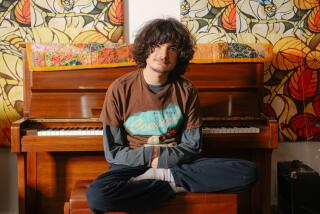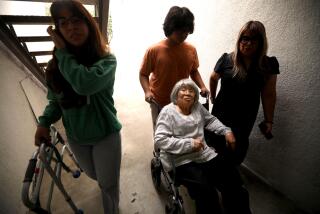Help for Parents of the Hearing-Impaired Child : Organization Provides the Emotional Support and Information to Help Families Cope With Deafness
- Share via
Six years ago, the lives of Robert and Mary Osbrink were shattered when they discovered that their 3-year-old son had lost his hearing. Today, families with deaf children have something the Osbrinks didn’t: someone to help pick up the pieces.
Families with hearing-impaired children can turn to Parent to Parent, an organization that the Osbrinks helped form in 1982 in association with the House Ear Institute of Los Angeles.
Support and Information
Information about deafness, educational opportunities, methods of communication, support services and the emotional support of “someone who’s been there” are offered by Parent to Parent to families without regard to the child’s age or form of communication (sign language, lip-reading, etc.)
“There’s kind of a ‘silent war’ going on out there,” said Mary Osbrink. “People (and organizations that deal with the hearing impaired) are so involved with their own form of communication or therapy--and they’re so dedicated to it--or a particular age group that there is no crossover.”
‘A Smorgasbord of Ideas’
Parent to Parent was established to bridge those gaps, with the help of the Tustin couple. Robert Osbrink, a vice president of a Newport Beach development company and a general partner of the $35-million Westdome sports arena project, said Parent to Parent is “not out to tell parents what choices to make. We’re just offering a smorgasbord of ideas.”
The Osbrinks’ crisis began when son Rory’s “flu” turned out to be a near-fatal case of spinal meningitis. Rory’s weight dropped by one-third--to about 24 pounds--during his half-month stay at the Childrens Hospital of Orange County, but he battled back and was able to return home on New Year’s Eve.
“We brought him home and the neighbors were shooting off fireworks to celebrate New Year’s, and we thought, ‘How rude! They know our son’s been sick,’ ” Robert Osbrink recalled. “But he didn’t wake up--nothing. And we thought, ‘Well, he’s just tired since he just got home today.’ ”
But a setback the next day put Rory back in the hospital. And during this stay, the Osbrinks’ suspicion that something was amiss was confirmed. Rory lost interest when his father entertained him with a favorite song; the boy “just didn’t seem right” to his mother. A test revealed Rory’s hearing loss was severe to moderate.
Vocabulary Shrank
As he began to talk less, his speech became slurred and his vocabulary shrank, his parents said. And the change in Rory was causing changes in the rest of the family. Mary Osbrink, 39, said she became very protective of her son; Robert Osbrink, 39, didn’t touch his guitar or listen to a radio for more than a year.
Rory was taken to “this first doctor who slaps his hands a couple times behind his (Rory’s) head and says, ‘OK, he’s deaf,’ and starts writing,” Robert Osbrink said. “I’d come home from work and Mary would be wiped out because she had called somebody and found out that they’re divorced, the kid is in an institution, the mother’s gone bananas and--we just had no positive input.”
Decisions about Rory’s medical treatment, therapy and education added to their worries, Mary Osbrink said.
“Here we are trying to make decisions that are going to affect this kid for the rest of his life, and we have people saying these terrible things to us about, ‘If you do that with your child he’ll never talk again.’ . . . All these professionals--and on the whole I think they’re really a great group--are all dedicated to their own discipline. But for a parent trying to make a decision, it’s like being bombarded with eggs.
“You have to make a decision about school--now! You have to get hearing aids on this kid--now! You have to do this--now! If you don’t, this and that. . . . Time is precious!”
Unable to find a place where they could “have a peaceful conversation with another parent,” said Mary Osbrink, the couple set out on their own, looking for the best care and schooling. While he was at work, she went on scouting missions.
“I did some terrible things,” she said. “I snuck into libraries and schools when nobody knew I was there to see the program when no one was there to walk me around. I really saw what was happening when no one knew a parent was there.”
At one school she toured, she was unable to find a student she knew. “I knew she wasn’t doing very well,” Mary Osbrink said, “but I badgered every single person there until finally they showed me this little girl. They had her in a separate room where the students were not doing the quality of work that I had been told about.”
“You just have a short amount of time to assimilate a lot of information,” said Robert Osbrink.
“And so many places to go,” said his wife. “You don’t want to be so involved with meetings and so on that you don’t see your deaf child--or your hearing child. And that almost happened to us with Rory going to school in Newport Mesa and his brother, Ryan, going to Tustin.”
The family’s first ray of hope came at the John Tracy Clinic in Los Angeles. There they met volunteer Ken Levinson, who told them that their son would probably be just fine. “I asked him how he knew,” said Robert Osbrink, “and he said, ‘I’m deaf and I’m just fine.’ We just had no idea that he wasn’t hearing us.”
Rory went elsewhere for his schooling, but the Osbrinks learned that the clinic’s parent support group (limited to parents whose children were being served there) was “our thing.” Through the clinic and its support group, the Osbrinks learned of a cochlear implant, an electronic device that enables the patient to distinguish sound, which was being implanted in children at the House Ear Institute. In May, 1982, Rory became the second child to have the device.
The House Ear Institute is a nonprofit organization dedicated to research and training of ear specialists in new methods of diagnosis and treatment. Founded in 1946 as the Los Angeles Foundation of Otology, it was renamed in 1981 after its founder and chairman emeritus, Dr. Howard P. House, and his brother, Dr. William F. House, president.
When the institute began selecting candidates for the implant, Mary Osbrink said, it had to deal with different age groups, different levels of education and teaching methods.
“And once (the institute) did that,” she said, “they realized, ‘Hey, we can’t deal with these basket-case parents. We’re going to have to try to do something to help these parents, too.’ ”
And the assistance goes both ways.
“Parents have become a very important aspect in our work,” said William House, developer of the implant. “They are a very important part of our research team.”
Parent Group Formed
With the help of William House, the Osbrinks and several other couples--including Noel and Larry Husted of Upland, Nina and Richard Thompson of Santa Monica--formed Parent to Parent. William House said he attends group meetings, but does not serve Parent to Parent in an official capacity. The parent group does not limit itself to discussing methods advocated by the House Institute.
Parent to Parent meets regularly to exchange ideas, celebrate successes, analyze failures and explore common concerns. The organization’s camping weekends and other family social outings often are the only times the siblings of hearing-impaired children have a chance to talk with each other, Mary Osbrink said.
With the help of parent liaison Ann Selmi, the group has put together a resource catalogue of books, pamphlets, periodicals, audio-visual materials and organizations on nine general topics: initial concerns, medical and audiological information, communications methods, child development, educational programs, support services, assisting devices and general readings. Resource librarian Sister Mark Szczepanik of the House Ear Institute has hundreds of titles catalogued.
Under the direction of consultant Karen House, production is winding up on the fifth of 10 videotapes on life with a hearing-impaired child. Video copies are available through the catalogue. The organization has fielded calls from throughout the United States as well as Europe and South America.
Debbie Corey, 35, of Claremont said she and husband John, 39, think of Parent to Parent as a secondary support group because they are involved with a child-parent program within the Pomona Unified School District. Their 6-year-old daughter, Christen, was enrolled in an auditory-verbal program there that parents also attend. John Corey said his daughter, who also has an implant, is being mainstreamed into a regular kindergarten class this year and is receiving extra tutoring.
“We stay with Parent to Parent,” Debbie Corey said, “because our daughter has had a cochlear implant through the House institute . . . and it gives us a chance to see how other children are progressing in other instructional settings.”
Parent to Parent’s immediate goals include finishing the video series and getting those tapes and the catalogue more widely distributed to doctors, hospitals and other support groups. The Lions Club, Kiwanis and other service organizations have helped with the distribution, said Robert Osbrink, president of the support group.
Rory reads lips and speaks now, which his parents thought impossible a few years ago.
“He’s really doing well in school,” said his mother. “It’s such a far cry from before.”
And the family has adjusted, she said. “We even let our 13-year-old (Ryan) baby-sit. Things can happen--and they do. But life has to go on. Rory’s got to do everything. I want him to experience everything that’s out there.”
More to Read
Sign up for Essential California
The most important California stories and recommendations in your inbox every morning.
You may occasionally receive promotional content from the Los Angeles Times.













